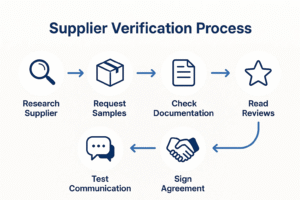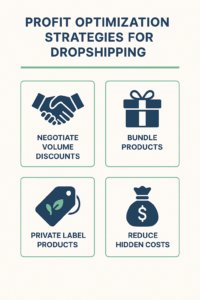Having a clever niche or an appealing dropshipping store is not the sole factor for achieving success in the dropshipping business. Selecting reliable suppliers that consistently provide high-quality products on time is essential. Many new entrepreneurs underestimate the significance of this stage. Numerous store owners believe their online business will run smoothly, only to discover too late that untrustworthy suppliers can silently compromise everything.
In reality, 84% of dropshipping businesses do not succeed in their first year. In nearly 70% of cases, supplier issues are the culprits. The National Retail Federation reports that online businesses currently incur an average loss of $1.1 million annually due to supply chain problems. That isn’t a threat; it’s a liability.
Ready to build a profitable dropshipping business with reliable suppliers? Get expert guidance from HiSellIt and avoid the costly mistakes that cause 70% of dropshipping failures.
Merely browsing supplier directories is insufficient. To establish dependable partnerships, it is essential to adopt a strategic mindset. This guide demonstrates how successful store owners in 2025 choose and collaborate with the best dropshipping suppliers by using proven evaluation techniques and platform insights.
Quick Answer: How to Find Reliable Dropshipping Suppliers
Fast Track Steps:
- Use verified supplier directories like Alibaba, Spocket, and Wholesale2B
- Request product samples to assess quality firsthand
- Verify all legal documentation and business registration
- Read customer reviews and supplier testimonials in detail
- Test responsiveness to your inquiries and follow-up questions
- Finalize service level agreements before onboarding any supplier
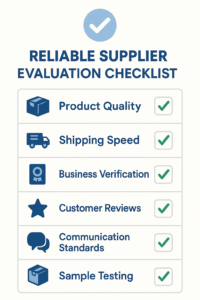
Finding Reliable Dropshipping Suppliers: Understanding the Landscape
In the past decade, the landscape of dropshipping suppliers has undergone a significant transformation. What began as the initial efforts of a handful of manufacturers experimenting with direct-to-consumer fulfillment has evolved into a comprehensive e-commerce supply chain industry, complete with dedicated dropshipping platforms designed specifically for online retailers. Understanding the current landscape is essential for identifying trustworthy dropshipping partners in 2025.
Types of Reliable Dropshipping Suppliers
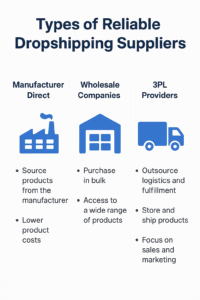
Manufacturer Direct Suppliers
These suppliers provide the greatest control over product quality and the highest profit margins. Interacting directly with manufacturers eliminates the need for middlemen, ensuring better supplier reliability. They are excellent for long-term growth as they offer superior quality control and more adaptable pricing, although they often require higher minimum order quantities or monthly commitments.
Wholesale Dropshipping Companies
These vendors act as a bridge between manufacturers and online stores. They offer a variety of products from multiple sources and handle all aspects of order shipping meticulously. Their convenience is unmatched; however, their markups often result in reduced profit margins for the dropshipping business.
Third-Party Logistics (3PL) Providers
3PL dropshipping providers have carved out a niche in the market by offering comprehensive solutions, including inventory storage, order processing, and fulfillment services. They are an excellent choice for e-commerce businesses aiming to scale quickly or expand operations without building a warehouse.
How to Find Trustworthy Suppliers: Essential Evaluation Criteria
When it comes to building a sustainable dropshipping business, choosing the right dropshipping supplier is non-negotiable. Even the best eCommerce marketing strategies can’t make up for poor product quality or unreliable order fulfillment. Here’s how to evaluate reliable dropshipping suppliers in 2025 using the criteria that matter most.
Reliable Dropshipping Suppliers: Product Quality Standards
Product quality remains one of the most important benchmarks when searching for the best dropshipping suppliers. Always request product samples before committing to any long-term partnership. Evaluate the materials, packaging, and overall build quality to ensure they align with your brand standards.
Reputable suppliers are usually open to sending samples, often at cost or even for free if you demonstrate serious intent. Be sure to ask about their quality control processes, including inspection routines, handling of returns, and policies for defective items. Suppliers that maintain ISO certifications or other internationally recognized standards demonstrate a strong commitment to consistency and product integrity.
Shipping Performance and Geographic Coverage
Fast, reliable shipping is now an expectation, not a luxury. Evaluate potential dropshipping suppliers based on their shipping times and how well they serve your target markets. Domestic suppliers often provide delivery within 2 to 7 days, while international partners may range from 7 to 21 days depending on the logistics network.
Look for suppliers with warehouse networks across multiple regions. A distributed fulfillment model helps reduce shipping costs and delivery times by routing orders through the nearest facility. Advanced logistics capabilities like these can significantly boost customer satisfaction and encourage repeat orders.
Communication Standards and Customer Service Quality
Clear, prompt communication is another critical trait of reliable dropshipping suppliers. During your evaluation, observe how quickly they respond to emails or platform messages. Can they communicate fluently in your preferred language? Are they available during your business hours?
Also, assess their customer service structure. Do they assign dedicated account managers? Is there a defined process for handling escalations or urgent issues? Top-tier suppliers prioritize communication and support, understanding that their service directly impacts your eCommerce reputation and long-term customer loyalty.
Best Dropshipping Suppliers 2025: Top Platforms and Directories
Identifying the best dropshipping suppliers in 2025 requires more than a quick online search. A reliable dropshipping supplier network forms the backbone of any successful eCommerce business. Whether you’re launching your first dropshipping store or expanding an existing one, working with vetted and trustworthy suppliers ensures consistent product quality, timely order fulfillment, and stronger profit margins.
Finding Reliable Dropshipping Suppliers on AliExpress and Alibaba
Alibaba continues to lead the B2B dropshipping marketplace sector, connecting online sellers with manufacturers across Asia. When sourcing from Alibaba, prioritize suppliers with Gold Supplier status, a strong transaction history, and consistently positive supplier reviews. Take advantage of Trade Assurance to safeguard your orders against fraud, delivery delays, or substandard products, ensuring a reliable dropshipping supplier experience.
AliExpress remains a solid option for beginners or businesses looking to test product-market fit before scaling their dropshipping business. While the platform tends to offer lower profit margins, it includes valuable features like buyer protection, reliable dispute resolution, and a wide product variety. Choose sellers with high ratings, proven order history, and responsive communication for a dependable dropshipping supplier experience.
Specialized Platforms for Trustworthy Suppliers
Beyond general dropshipping marketplaces, several specialized dropshipping platforms cater specifically to dropshipping businesses, offering tighter quality controls and improved shipping speeds.
- Oberlo (now integrated into Shopify) simplified the process of finding and importing products directly into your dropshipping store. Though Oberlo as a standalone tool was discontinued, its core features live on within the Shopify ecosystem, streamlining supplier integration and order automation for eCommerce businesses.
- Spocket focuses on pre-vetted dropshipping suppliers based in the United States and Europe. This platform is particularly effective for stores targeting Western customers who expect faster shipping and higher product quality.
- Wholesale2B grants access to over one million products from US-based suppliers. With built-in inventory syncing and shipping automation, it is especially useful for businesses focused on the North American market.
Industry-Specific Directories
For niche product categories, general dropshipping platforms may not offer the level of specialization needed. In these cases, explore supplier directories tailored to your specific industry.
- ThomasNet is ideal for industrial, OEM, and manufacturing dropshipping suppliers based in the United States. It offers a robust vetting process and a focus on commercial-grade products.
- FashionGo serves as a dedicated marketplace for apparel and accessories. The platform connects fashion-forward retailers with wholesalers experienced in fast-turnaround fashion dropshipping products.
These targeted directories often attract higher-quality suppliers with deep category knowledge and proven order fulfillment capabilities.
Struggling to identify reliable suppliers for your dropshipping business? Contact HiSellIt’s experts for professional supplier vetting and dropshipping automation services that eliminate guesswork.
How to Find Trustworthy Suppliers: Due Diligence and Verification
Once potential suppliers are identified, the next step is verification. Effective due diligence minimizes risk, protects your brand reputation, and ensures operational reliability.
Verifying Reliable Dropshipping Suppliers: Business Registration
Before establishing a formal relationship, verify that a supplier operates as a legitimate business. Ask for key documentation such as business licenses, tax identification numbers, and applicable certifications.
- In the United States, use state-level databases to confirm registration details.
- For international suppliers, consult local trade associations or chambers of commerce.
Reliable suppliers are typically transparent about their legal structure and will not hesitate to provide documentation or participate in video calls to validate their operations.
Financial Stability Assessment for Trustworthy Suppliers
A supplier’s financial health plays a crucial role in their ability to fulfill orders consistently and scale with your business. While direct access to financial reports is rare, you can still evaluate stability based on:
- Years in operation and track record
- Size of their workforce and physical facilities
- Investment in logistics, automation, and platform integration
- Availability of client testimonials and case studies
- Payment flexibility and terms offered to recurring partners
These factors signal whether a supplier has the infrastructure to support long-term partnerships and volume growth.
Reference Verification and Third-Party Reviews
Ask prospective suppliers to share references from current or past clients in your industry. When reaching out, inquire about key metrics such as fulfillment speed, order accuracy, and responsiveness to issues.
Additionally, check platforms like Trustpilot, the Better Business Bureau, and specialized industry forums for unbiased feedback. Third-party reviews often reveal supplier behavior under pressure, which shows how they manage disputes and unexpected challenges.
Red Flags: Avoiding Unreliable Dropshipping Suppliers
Establishing a dependable supply chain starts with knowing what to avoid. While finding the best dropshipping suppliers 2025 is essential, it’s equally important to recognize red flags that can damage your brand reputation or disrupt operations. Early warning signs typically appear in pricing, communication, transparency, and supplier behavior.
Pricing Warning Signs When Finding Trustworthy Suppliers
If a supplier’s pricing seems excessively favorable, it’s likely not genuine. Unusually low prices can signal poor product quality, counterfeiting risks, or hidden fees that appear after onboarding.
Before proceeding, investigate the full cost structure:
- Ask about shipping rates, return fees, and handling charges.
- Clarify minimum order quantities and packaging costs.
- Evaluate refund and warranty policies carefully.
Sustainable suppliers maintain healthy margins that support quality control and service reliability. Dropshipping operations based on unsustainably low prices are often unstable and prone to quality breakdowns.
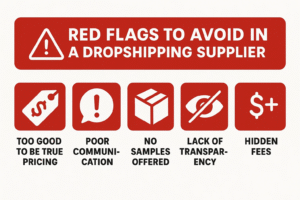
Communication Red Flags in Best Dropshipping Suppliers 2025
Clear communication is a foundational trait of any reliable supplier. Poor responsiveness during initial outreach tends to worsen after onboarding. Watch for these common red flags:
- Vague or delayed replies to specific inquiries
- Pressure to commit quickly without time for due diligence
- Refusal to provide product samples or verifiable references
- No professional email address or missing business details
- Exclusive communication via informal apps instead of formal channels
Reliable dropshipping suppliers value professional communication, understand its importance, and respond clearly and promptly.
Transparency Issues with Potential Suppliers
Suppliers unwilling to share basic operational details should not be considered. Transparency around capabilities, processes, and limitations is a hallmark of trustworthy suppliers. Avoid suppliers who:
- Do not disclose a verified business address or legal registration
- Refuse to share shipping timelines or return handling policies
- Avoid discussing inventory procedures or product sourcing
- Will not engage in a video call or allow a virtual tour
Lack of transparency typically reflects poor infrastructure, potential legal issues, or a lack of professional integrity.
Building Strong Relationships with Reliable Dropshipping Suppliers
Once trustworthy suppliers are identified, building and maintaining strong relationships becomes key. Long-term partnerships lead to better pricing, priority treatment, and operational reliability.
Negotiation Strategies for Trustworthy Suppliers
Approach negotiations with mutual value in mind. Building sustainable, long-term partnerships often yields better results than hardline bargaining.
Focus on these key negotiation areas:
- Pricing and Payment Terms: Competitive pricing is important, but quality and reliability should guide your decisions. Slightly higher prices from the best dropshipping suppliers in 2025 often deliver higher customer satisfaction and fewer operational issues.
- Exclusive Arrangements: If you’re selling a unique product or targeting a niche market, consider negotiating territorial or product exclusivity. These arrangements strengthen your competitive edge and solidify supplier loyalty.
- Service Level Agreements (SLAs): Formalize expectations regarding delivery times, defect rates, communication timelines, and return handling. SLAs reduce misunderstandings and support measurable performance standards.
Managing Multiple Trustworthy Supplier Relationships
Relying on a single supplier introduces unnecessary risk. Diversification provides leverage in negotiations, safeguards against disruptions, and supports flexible scaling.
Maintain strong oversight across suppliers by tracking:
- Order volumes and frequency by supplier
- Defect reports and resolution timelines
- Communication records and escalation history
- Financial terms and payment status
- On-time delivery and fulfillment accuracy
Use SRM (Supplier Relationship Management) tools or structured spreadsheets to centralize and organize supplier performance data.
Performance Monitoring and Improvement
Establishing KPIs (Key Performance Indicators) allows consistent evaluation of each supplier’s performance. Monitoring performance fosters accountability and improvement.
Recommended KPIs include:
- Order accuracy and fulfillment rates
- On-time delivery percentages
- Product defect frequency
- Customer satisfaction metrics
- Response time to support inquiries
Conduct regular performance reviews with each supplier. Share successes, address issues professionally, and create action plans for continuous improvement.
Technology Integration and Automation
As your dropshipping business scales, technology becomes critical. You must equip reliable dropshipping suppliers with the ability to integrate with your systems for efficient operations.
Inventory Management Systems
Inventory sync in real-time prevents stockouts and order cancellations. Look for suppliers who provide API integration or partner with inventory management platforms that support automation.
Popular systems include:
- SkuVault: Offers robust inventory and warehouse visibility
- QuickBooks Commerce (formerly TradeGecko): Streamlines multi-channel operations and connects with accounting tools
- Cin7: Optimizes stock across channels with predictive analytics and automation
These systems help ensure your store reflects real-time product availability and shipping timelines.
Order Processing Automation
Efficient order processing reduces human errors and speeds up fulfillment. Evaluate your suppliers’ tech capabilities, especially in the following areas:
- Electronic Data Interchange (EDI): Automates order flow between platforms
- Order tracking integration: Enables automatic shipment updates and tracking number sync
- Real-time status updates: Keeps customers informed and reduces support inquiries
Seamless automation reduces overhead and improves customer experience. For businesses looking to scale across multiple platforms, consider exploring Walmart dropshipping automation services that can complement your supplier relationships.
Data Analytics and Reporting
Data visibility across the supply chain supports smarter decisions. Leading suppliers provide access to dashboards or analytics that highlight:
- Sales trends and product performance
- Seasonal demand fluctuations
- Geographic fulfillment breakdowns
- Product return rates and common issues
- Net promoter scores and satisfaction trends
This reporting empowers data-driven optimization of your product strategy and supply chain management.
Cost Analysis and Profit Optimization
Sustaining profitability in dropshipping depends on understanding your full cost structure, not just the supplier’s price tag. To maximize profit margins, a detailed cost breakdown and strategic planning are essential.
Understanding the Total Cost Structure
The true cost of fulfilling each order involves multiple variables. Accurately calculating your total landed cost means accounting for:
- Product cost from the supplier
- Payment gateway fees
- Selling platform commissions (e.g., Shopify, Amazon, Etsy)
- Paid advertising and influencer marketing
- Customer service expenses
- Order return processing and refunds
Overlooking even one of these can lead to underpricing and eroded margins.
Hidden Fees and Additional Charges
Carefully review supplier agreements and platform policies to avoid surprise costs that impact profitability:
- Setup or onboarding fees disguised as processing charges
- Monthly account or membership maintenance fees
- Pre-order handling or transaction fees
- Expedited shipping premiums or weekend surcharges
- Return processing and restocking fees
- Currency conversion costs when working with overseas suppliers
Even small fees can add up and quietly reduce your margins if not tracked closely.
Strategies for Improving Profit Margins
Profit optimization isn’t about cutting corners; it’s about working smarter across your supply chain. Apply these strategies to improve margins sustainably:
Volume Discounts
Negotiate better pricing based on sales volume. Tiered discounts based on monthly or quarterly performance can lead to significant savings.
Product Bundling
Combine complementary products into bundled offers. This increases average order value while delivering greater perceived value to customers.
Private Labeling
Once a product proves successful, explore private labeling. Branded products command higher prices and build customer loyalty, which improves profit over time.
International vs. Domestic Suppliers
When choosing between domestic and overseas dropshipping suppliers, it is essential to consider product pricing, delivery speed, and customer satisfaction. Each option has unique advantages and disadvantages, often influenced by your industry niche and business model.
Advantages of Working with Domestic Suppliers
US-based dropshipping vendors offer greater reliability, quicker shipping times, and improved communication. The primary benefits include
- Reduced delivery times: Shipping typically occurs within 2 to 5 days, aligning with consumer expectations and minimizing refund requests.
- Improved communication: Sharing the same language, time zone, and business processes facilitates smoother interactions.
- Enhanced quality standards: Assessing the quality of products manufactured in the US is easier due to stricter manufacturing regulations.
- Streamlined returns: Handling returns is faster, more cost-effective, and simpler.
These advantages often result in increased sales conversions and improved long-term customer loyalty for your dropshipping business.
International Supplier Considerations
- Lower product costs: Labor and production expenses are significantly reduced, potentially saving 30% to 70% on costs.
- Access to unique products: Overseas suppliers may offer trendy or niche items not available domestically.
- Private label dropshipping options: Many international manufacturers allow you to personalize and brand products with reduced minimum order quantities.
Challenges to consider:
- Extended shipping times may increase customer complaints.
- Language and cultural barriers impact communication.
- Difficulty enforcing quality control from a distance.
- Risks from currency exchange fluctuations.
- Customs holds and additional import duties.
To mitigate these risks, plan ahead, set clear expectations, and establish solid agreements with your international dropshipping partners
Legal Considerations and Compliance Issues
Running a professional dropshipping business requires a solid understanding of trade laws, customs regulations, and intellectual property protections. Compliance prevents legal disputes and protects your store from suspension or bans.
Import Regulations and Customs Requirements
Importing products comes with specific rules depending on the country of destination. Ensure all products comply with the necessary legal standards before shipment.
Key compliance factors include:
- Product Classification: Use accurate HTS (Harmonized Tariff Schedule) codes to determine duties and legal requirements.
- Safety Certifications: Some products must meet standards such as FCC (electronics), CE (European conformity), or FDA (health-related items).
- Labeling and Documentation: Products may require country-of-origin labels, language-specific instructions, or warning labels.
- Restricted or Banned Items: Avoid products with import restrictions unless you hold the appropriate licenses.
Working with customs brokers can streamline this process and prevent unexpected delays.
Intellectual Property Protection
Protect your business by ensuring your suppliers are authorized to sell the products you’re listing. Selling counterfeit or infringing items can cause major setbacks.
Verify supplier legitimacy by:
- Requesting documentation proving brand authorization or original manufacturing
- Asking for licenses or legal use agreements for any branded products
- Avoiding “too-good-to-be-true” deals on brand-name goods without clear origin
Violations can result in:
- Account suspension or permanent bans on platforms like Amazon, eBay, or Etsy
- Cease-and-desist orders or lawsuits from brand owners
- Heavy fines or loss of customer trust
Tax Implications and Record Keeping
Stay ahead of tax obligations by maintaining detailed records of all financial transactions with your suppliers.
Track and store:
- Supplier invoices and receipts
- Import/export documentation
- Proof of payments and currency conversions
- Product pricing history and fee breakdowns
- Return and refund processing records
Different jurisdictions have varying rules for sales tax, VAT, and income reporting. Consult a tax professional experienced in e-commerce and international logistics to ensure complete compliance.

Scaling Your Supplier Network
As your dropshipping business grows, your supplier network must evolve to support increasing order volumes, new product categories, and regional expansion. Strategic supplier scaling ensures consistent performance, customer satisfaction, and competitive positioning in dynamic markets.
When to Add New Suppliers
Expanding your supplier base should be a calculated move, not just a reaction to short-term demand. Consider onboarding additional suppliers when:
- Current suppliers struggle to meet growing demand
- You plan to introduce new product categories or expand your catalog
- New geographic markets require local fulfillment partners
- Risk diversification becomes necessary for stability
- Better pricing or service opportunities present themselves
Adding suppliers at the right time helps maintain fulfillment speed, product quality, and customer trust while supporting your business’s upward trajectory.
Managing Supplier Portfolio Diversification
An optimized supplier network balances efficiency with resilience. Overreliance on a few vendors can expose your business to unnecessary risk, while managing too many can reduce operational control. Consider these approaches:
The 80/20 Rule
Focus 80% of your attention and resources on the top 20% of suppliers contributing the most value, revenue, or product reliability.
Geographic Diversification
Reduce the risk of localized disruptions, such as political instability, natural disasters, or customs delays, by spreading your supply chain across multiple regions.
Capability Complementarity
Choose suppliers whose unique strengths complement each other. For instance, one may excel in fast domestic shipping while another offers better customization for international orders.
Transitioning Between Suppliers
Switching suppliers, whether for cost, quality, or capacity reasons, requires careful execution to avoid service disruptions or customer dissatisfaction.
Key best practices include:
- Overlap Period: Maintain both old and new supplier relationships temporarily to ensure continuity
- Inventory Coordination: Manage inventory buffers to avoid backorders or overstocks during the transition
- Customer Communication: Inform customers of any temporary changes in delivery times or product availability
- Performance Monitoring: Closely track order accuracy, delivery speed, and issue resolution during the early stages
- Backup Plans: Always have contingency suppliers in place in case the transition does not go as planned
Proactive planning ensures a smooth transition and preserves customer experience throughout the switch.
Ready to scale your dropshipping business with professional automation and supplier management? Explore HiSellIt’s comprehensive services including Etsy automation and multi-platform dropshipping solutions.
Frequently Asked Questions
Q: What are the signs to identify a legitimate dropshipping provider?
To ensure a dropshipping supplier’s integrity, examine their business registration, client references, third-party reviews, and any relevant business licenses or certifications. Genuine suppliers will gladly provide this information. Video calls can also help verify their business location and operations.
Q: How do manufacturers differ from wholesale dropshippers?
Manufacturers enable direct quality control and higher profit margins, although this may require purchasing larger quantities. Wholesale dropshipping businesses simplify operations by sourcing products from multiple producers, which allows them to offer a wider product range; however, this often results in lower profit margins. Manufacturers are ideal for building long-term product relationships, while wholesalers excel at offering diverse catalogs and market options.
Q: How can I negotiate better terms with dropshipping suppliers?
Prioritize long-term partnerships over one-off transactions. Demonstrate your potential for business growth and promotion. Key priorities in supplier negotiations include exclusive product partnerships, volume-based pricing structures, payment terms, and service level agreements. Use sales data and growth projections to strengthen your position.
Q: Should I collaborate with a single supplier or multiple suppliers?
Working with a single reliable dropshipping supplier can secure more favorable terms and strengthen relationships. However, partnering with multiple suppliers reduces risk and increases negotiating power. Start with a dependable supplier and expand as your dropshipping business grows. Unless you hold exclusive contracts, keep a balanced supplier portfolio so no single provider accounts for more than 60–70% of your revenue.
Q: How can I address quality issues with international suppliers?
Set detailed product specifications and obtain sample approvals before committing to large orders. For inspections, hire third-party quality control services or trusted local agents. Discuss costs for returning defective products and timelines for replacements. Choose vendors offering quality guarantees or conducting inspections before shipment. Building strong supplier relationships and maintaining clear communication speeds up issue resolution.


